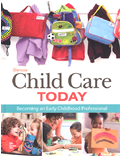
Child Care Today ©2012Chapter 11: Schedules and RoutinesChapter SummaryA thorough plan can make both a child and early educator’s day go smoothly. Structured, well-planned days help children behave appropriately. Schedules are planned according to a program’s type and length, children’s ages, a program’s size and class groupings, and the physical facility. Schedules plan events in the order they will occur and indicates how long each event will last. Predictable schedules create a secure, stable environment to help children become more self-directed. Days should be interesting and engaging, but should not overstimulate children. Pacing should be active enough to keep children’s attention, but not rushed to cause frustration. Activities for all developmental areas should be included, and there should be opportunities for active and quiet play. Plan time for individual attention, as well as large- and small-group activities. Children need a balance of indoor and outdoor play. Routines may be short or long. Routines help children learn what to expect during the day. There are routines for every part of the day, including arrival, health check, daily kick-off, playtime, mealtimes, nap times, and departure. Over time, routines develop children’s self-help skills. Transitions guide children smoothly from one event to another. Transitions take place throughout the day. Signals or short activities that prompt children to move from one place to another are called transition techniques. These can include chore boards, job jars, and choice time. |  |















